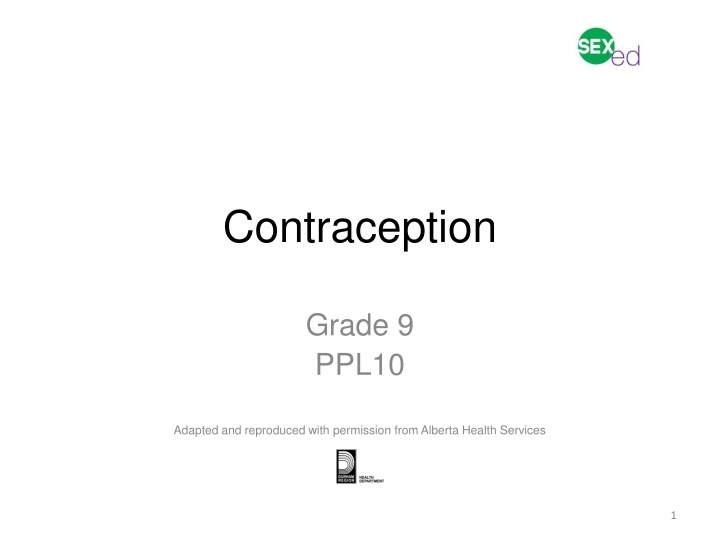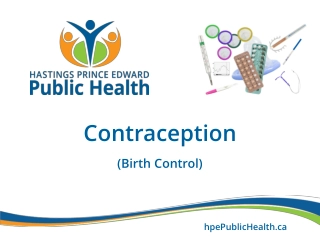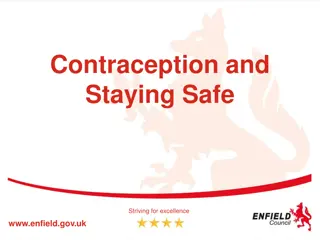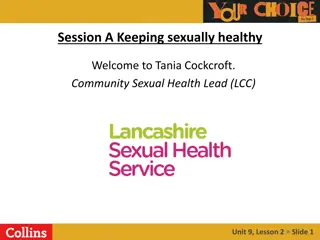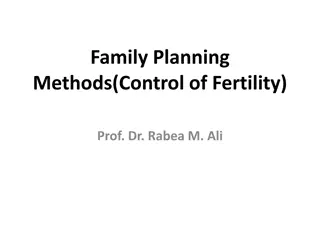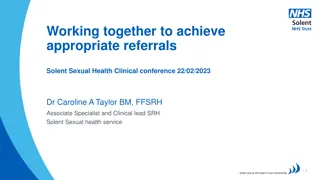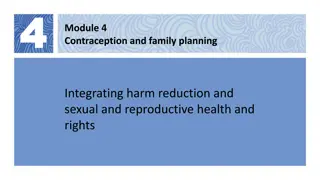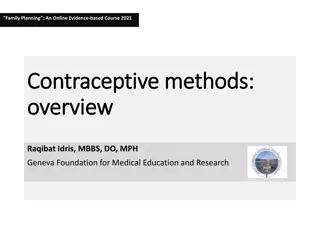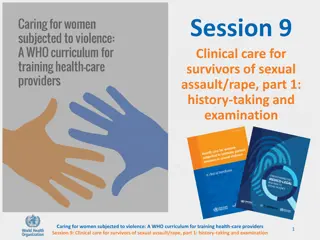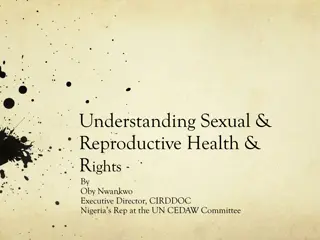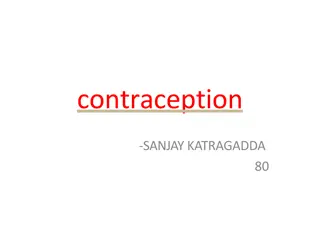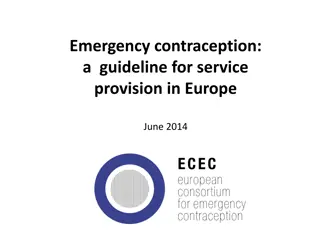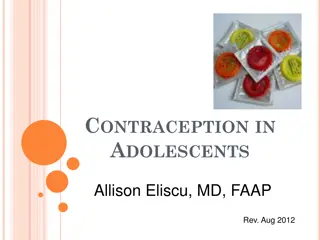Contraception
Contraception involves preventing fertilization of an egg or implantation of a fertilized egg. Learn about contraceptive types, effectiveness in preventing pregnancies and STIs, and why it's crucial to have factual information for making healthy decisions. Explore various methods, from hormonal and non-hormonal to barrier options and more. Test your knowledge with a Birth Control Pre-Test to assess your understanding of contraception.
Download Presentation

Please find below an Image/Link to download the presentation.
The content on the website is provided AS IS for your information and personal use only. It may not be sold, licensed, or shared on other websites without obtaining consent from the author.If you encounter any issues during the download, it is possible that the publisher has removed the file from their server.
You are allowed to download the files provided on this website for personal or commercial use, subject to the condition that they are used lawfully. All files are the property of their respective owners.
The content on the website is provided AS IS for your information and personal use only. It may not be sold, licensed, or shared on other websites without obtaining consent from the author.
E N D
Presentation Transcript
Contraception Grade 9 PPL10 Adapted and reproduced with permission from Alberta Health Services 1
Lesson Content Examine aspects of healthy sexuality and responsible sexual behaviour. Identify and describe types of contraceptives. Describe the effectiveness of methods of birth control in preventing pregnancies and sexually transmitted infections. Identify sources and information where students can go to get support on contraceptive methods. 2
What is Contraception? Contraception occurs by either preventing the fertilization of an ovum (egg) by the sperm cell, or preventing the embryo (fertilized egg) from implanting into the lining of the uterus 3
Why is it important to learn about contraception? Factual information is critical to make healthy decisions now and in the future 4
Methods of Contraception What are Some Methods of Contraception? Hormonal e.g. Combined hormonal contraceptives the pill , patch, ring, IUS, Depo, Emergency Contraception Pill (ECP) Non Hormonal e.g. Copper IUD Barrier- e.g. Condoms, dental dam Spermicidal- e.g. Foam Unreliable- e.g. Douching, withdrawal Other- e.g.Abstinence 5
Test your Knowledge Birth Control Pre-Test 1. Feminine hygiene products may be used as a contraceptive method. 2. A woman can become pregnant without having sexual intercourse. 3. Withdrawal is considered to be an effective contraceptive method. 4. Using both a condom and the pill is considered to be a very effective contraceptive method. Douching is not a good method of birth control. 5. 6. A female must have an orgasm to become pregnant. 7. The IUD is a good option for birth control. 8. A condom and a diaphragm are the same. 9. The pill must be prescribed by a healthcare professional. 10. The most effective contraceptive method for preventing the spread of STI is a condom. 11. On average, pregnancy in teens results in more health problems than taking the pill. 12. After ejaculation, sperm may live longer than 48 hours. 13. If a woman missed taking the pill, she should use some other form of contraceptive, like a condom for the rest of that month with the pill. A woman is safe from pregnancy if sexual intercourse occurs during menstruation. 14. 6
1. Feminine hygiene products may be used as a contraceptive method FALSE Feminine hygiene products include tampons, pads, and douches. None of these products are an effective contraceptive method 7
2. A woman can become pregnant without having sexual intercourse TRUE Even if there is no penetration of the penis, sperm can come in contact with the vagina if ejaculation occurs outside of the female near her vagina or on an area of the body brought in contact with the vagina 8
3. Withdrawal is considered to be an effective contraceptive method FALSE There can be sperm cells contained within pre- ejaculate which is released form the penis prior to ejaculation. These sperm cells can cause pregnancy 9
4. Using both a condom and the pill is considered to be a very effective contraceptive method TRUE An added advantage is that combining a hormonal method with a condom provides good STI protection. Abstinence is the only 100% effective method 10
5. Douching is not a good method of birth control TRUE Douching is not a reliable method of birth control. Not only is douching (washing out the vaginal canal with a water solution) an ineffective method of birth control, it is not a recommended practice because it can create an imbalance in the natural pH levels of the vagina 11
6. A female must have an orgasm to become pregnant FALSE Pregnancy occurs when sperm fertilizes an egg. This can happen whether or not a female has had an orgasm 12
7. The IUD is a good option for birth control TRUE The Intrauterine Device (IUD) or Intrauterine System (IUS) can be prescribed by a health care provider Hormonal Intrauterine Systems are 99.8% effective. A copper IUD (non hormonal) is up to 99.4% effective 13
8. A condom and a diaphragm are the same FALSE While they are both barrier methods, only condoms provide protection against pregnancy and STI 14
9. A healthcare professional must prescribe the pill TRUE Prescriptions can be written by: a family doctor a doctor or nurse practitioner at a walk in clinic a doctor or nurse practitioner at a Sexual Health Clinic 15
10. The most effective contraceptive method for preventing the spread of sexually transmitted infections is a condom FALSE Abstinence is the only 100% effective method for preventing the spread and transmission of STI 16
11. On average, pregnancy in teens results in more health problems than taking the pill TRUE During the first three months of pregnancy, 7 out of 10 pregnant teens do not see a doctor or go to a clinic, placing the mother s health at risk Teen mothers are at increased risk for low birth weight and pre-term infants, as well as infant death 17
12. After ejaculation, sperm may live longer than 48 hours TRUE Sperm can live 3 to 5 days after ejaculation 18
13. If a woman missed taking the pill, she should use some other form of contraceptive, like a condom for the rest of that month with the pill TRUE Missing any hormone pills, may increase your risk of pregnancy Call your healthcare provider for instructions and use a backup method of birth control (such as condoms) and think about getting Emergency Contraception (EC) if you have had unprotected sex in the last 5 days 19
14. A woman is safe from pregnancy if sexual intercourse occurs during menstruation FALSE There is no safe time for intercourse in order to prevent a pregnancy Every woman s cycle is different and ovulation can occur at any time during the menstrual cycle 20
Contraceptive Methods Effectiveness Bacterial STI Viral STI Method Do you need a prescription? Where can you get this method? Abstinence Birth control Pill Evra Patch Depo Provera Nuva Ring Plan B Emergency Contraceptive pill (ECP) Female Condom Male Condom Dental Dam IUD Spermicides- Vaginal film, gels, foams, sponge Diaphragm Withdrawal 21
What do you think is the best method of contraception? Abstinence is the only 100% effective method if used properly 22
What do you think is the best method of protecting oneself from STI? Abstinence If someone is sexually active, dual protection (the use of hormonal contraception and a condom) is the best protection 23
If a teen chooses to have sexual intercourse, what skills are they going to need? Ability to go for STI testing Comfort with one s own body Comfort discussing pregnancy, birth control and STI with a partner, a health care provider and other important people in one s life Ability to go to a pharmacy or health/family planning clinic to access the contraceptive supplies 24
Remember! Using contraception is a shared responsibility 25
